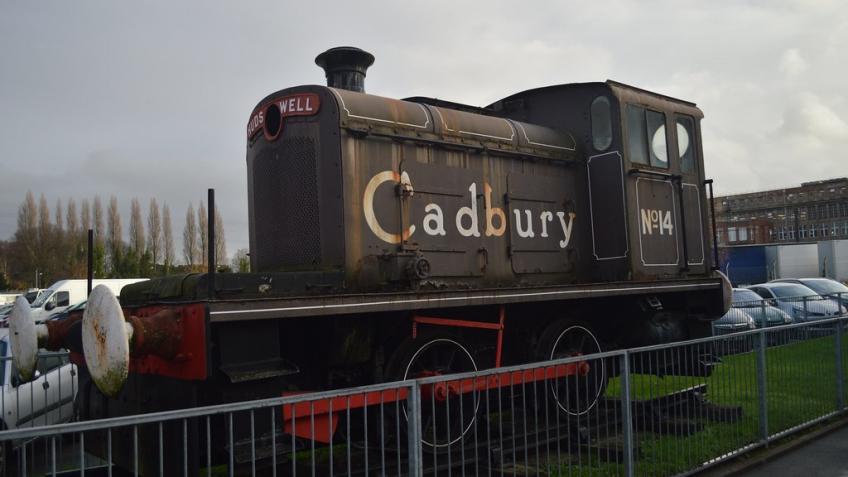We the Gloucester Railway Carriage and Wagon Museum have set up this Crowdfunding page to help raise the funds to transport Hudswell Clarke D1012 of 1956 "Cadbury No.14" from its current location at Cadbury World in Bournville, Birmingham to join the Museum's collection. To find our more above "Cadbury No.14" and Cadbury's links with Gloucestershire, please see below...
History of Hudswell Clarke D1012 “Cadbury No.14”:
Cadbury No.14 was built by Hudswell Clarke to Works Number D1012 with a Gardner 107HP 6LW engine in August 1955 and went to work at the Cadbury’s Moreton Factory in September 1956. It is a Diesel Mechanical with 3’0” wheels and weighs 20 Tons. The locomotive had a top speed of 14mph and could haul up to 200 Tons.
It worked for Cadbury’s until the locomotives retirement in 1977 when it went initially to the Llangollen Railway from the Moreton depot in Wirral. While at the Llangollen Railway it was operational until 1979. It was last recorded at the Llangollen Railway in 2002.
From 9th March 2003 it went to the Cadbury World entrance where it was put on display until 9th May 2006, it then went to Premier Brands Ltd, Moreton, Wirral, Merseyside, returned to Cadbury World’s car park once again in February 2007. It had formerly been at Cadbury Schweppes Moreton site and donated to Cadbury by Burton’s Foods who now operate the former Cadbury Moreton site in the same month.
It spent a short period at Tyseley in c.2008. It returned once more to Cadbury World’s car park where it has sat ever since on display for all to see. It was then donated to ourselves in 2019/20.
We would like to thank our friends at Cadbury World for their donation of Cadbury No.14 to the Museum collection and we would be extremely pleased to keep them updated and posted on the overhaul and future of the locomotive. We can now look at raising the required funds for the locomotives removal from the carpark at Cadbury World in Bournville, Birmingham before any restoration work can take place.
Association with Cadbury’s Chocolate Factory/Cadbury Brothers Limited in Gloucestershire:
The first link and connection between Gloucester and the Cadbury works in 1884 when a small line and exchange sidings were opened off of the Birmingham and Gloucester Railway who constructed a line between Birmingham and Gloucester that was opened in stages in 1840 and the station known as Bournville (formerly Stirchley Street and Bournville/Bournville and Stirchley Street) on the 3rd April 1876.
Bournville was In 1915 Cadbury’s began acquiring the land under the Defence of the Realm Act to build a milk producing factory alongside the wharf to the north of Fretherne bridge, Frampton-on-Severn “Frampton”, Severn Vale, Gloucestershire. Building work commenced during 1915 and by April 1916 the factory was fully operational.
Frampton was well located in the Vale , but was crucial advantage was the canal and inland waterways. The cocoa beans arrived at the Ports of the Bristol Channel where they were unloaded onto barges and brought up the river and canal to Frampton. Milk came in churns mainly from the Berkeley Vale area but also from further a field to the factory in a number of different ways mostly by horse and cart, motor lorry and along the canal although one person has been recorded to deliver a couple of buckets a day by bicycle.
Once at the factory the milk was pasteurised and was combined with the cocoa beans to make what is known as ‘chocolate crumb’ and the milk was initially used in chocolate production, by 1917 the government required Cadbury’s to produce condensed milk at Frampton, and later cheese. Frampton also supplied Birmingham with pasteurised milk during 1918.
As men were conscripted, women gradually took over their places, but Cadbury’s kept the servicemen’s jobs open in case they were able, or wanted, to return to them after the war (World War I).
The ‘chocolate crumb’ was then loaded into narrow boats to be taken up the canal, onto the River Severn, through Gloucester passed the Gloucester Railway Carriage and Wagon Works on the bank of the Gloucester and Sharpness Canal (and Bristol Road) and via the Staffordshire and Worcestershire Canal to the Cadbury Factory at Bournville, which was also situated near the canal.
The new factory at Frampton was obviously very significant socially for the area because of the jobs it provided as an alternative to the only real major employment in the area being farm work and is possibly one of the many reasons why the first local authority housing was built in the village during the 1930’s. It remained a significant local employer and possibly the only significant local employer until the factory’s final closure in 1982.
Cadbury’s is well known as a paternalist employer, and this was soon shown in Frampton, where sports facilities were were provided on spare ground off Lake Lane: the Bowling Green in 1922, and later tennis courts and the first class cricket field. In addition, there was a small pavilion which was rebuilt in 1936 to mark the Silver Jubilee of King George V. This created the existing main hall and stage, with a range of changing rooms and kitchen alongside. (Similarly the Gloucester Railway Carriage and Wagon Company did very similar with regards providing a sports facility which was to be located on Tuffley Avenue, Gloucester in c.1910).
In 1948, there was an acute locomotive shortage with Cadbury No.1 (now preserved at Tyseley Locomotive Works/Vintage Trains in Birmingham) and No.6 away for repair and Cadbury still awaiting the delivery of No.9. As the curves in the factory were severe, only ex-Midland Railway 0-4-0ST’s could be utilised for loan to Cadbury. One of which was Gloucester based 41537 arrived in June 1948 and was back at the Gloucester Barnwood Locomotive Shed by October 1948.
In February 1961 the last 30 ton boat load of chocolate crumb left Cadbury's Frampton Milk Depot on the Gloucester and Sharpness Canal for Bournville, Birmingham.
When the Frampton factory closed, the whole sports facility was offered to the Parish Council, but sadly it rejected taking on the responsibility, and instead, some land was brought by the County Council for the new school; some was sold for housing; and the northern section was brought by the Community Association for the recreation ground. The County Council’s area included the Sports Pavilion, which they leased by the Community Association in 1987, and with two major redevelopment projects in the late 1980’s and early 1990’s, it was turned into the present community centre.
Other interesting information:
Our research shows that throughout the early years of Cadbury they used a mixture of wagons and rolling stock including their own Cadbury Bournville branded Wagons and Vans as those of the Midland Railway and its successor the London, Midland and Scottish Railway. A photograph (pictured below) featured in Derek Sharpe's Book entitled "The Railways of Cadbury and Bournville" taken in 1933 featured 'Cadbury No.1' can be seen pulling an LMS Steel Sided Ventilated Goods Van which in some ways resembles or looks exactly like those built by Metro Cammell/Metropolitan Carriage and Wagon (total built 400, lot 484), Gloucester Railway Carriage and Wagon Company Limited (total built 300, lot 485), Charles Roberts (total built 150, lot 486), Pickering (total built 150, lot 487), of which only two survivors of this type to Diagram Number D1828 (D1829) exists, one M179162 (Metro Cammell) owned by Somerset & Dorset Railway Museum Trust and M187085 (Gloucester) which is privately owned and is on permanent loan to the museum.
The future for ‘Cadbury No.14’:
The Gloucester Railway Carriage and Wagon Museum have extensive plans for the future of No.14, which are as follows:
- To raise the funds of £3,995plus VAT (£799) total of £4,794 required for the transport of Cadbury No.14 to its new home with the Gloucester Railway Carriage and Wagon Museum.
- To raise the initial funds for overhaul of the locomotive which will will include shipping (at the cost of £250) of the original Gardner engine to a specialist restoration and workshop facility where a full inspection and list of required work will be drawn up and costs agreed before any work will be undertaken and for upgrading/updating for use on the heritage railway network in the UK and the fitting of a vacuum and/or air braking systems.
- To repaint and fully restore the locomotive back into it's original Cadbury livery (see photo below).
- To offer Cadbury No.14 for loan to heritage railways and other preservation groups and societies.

